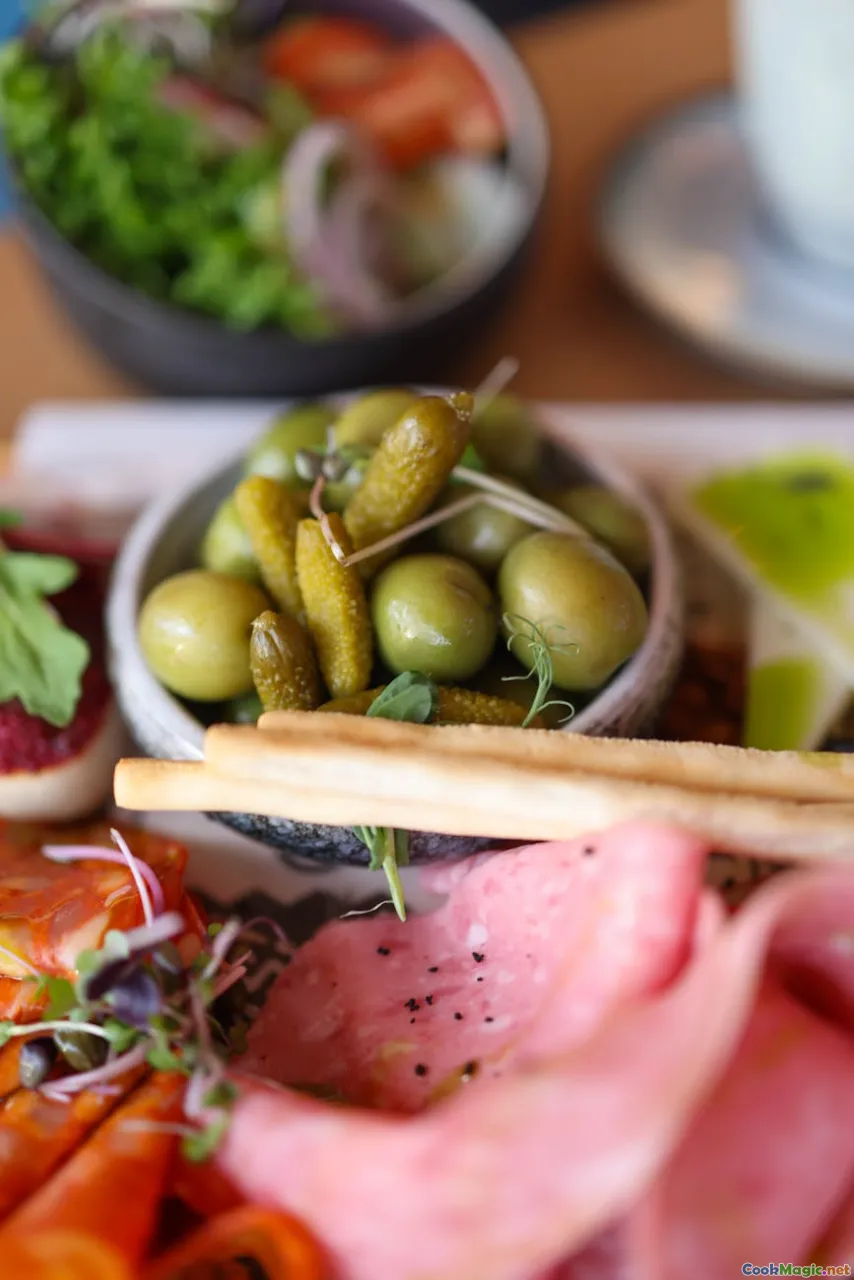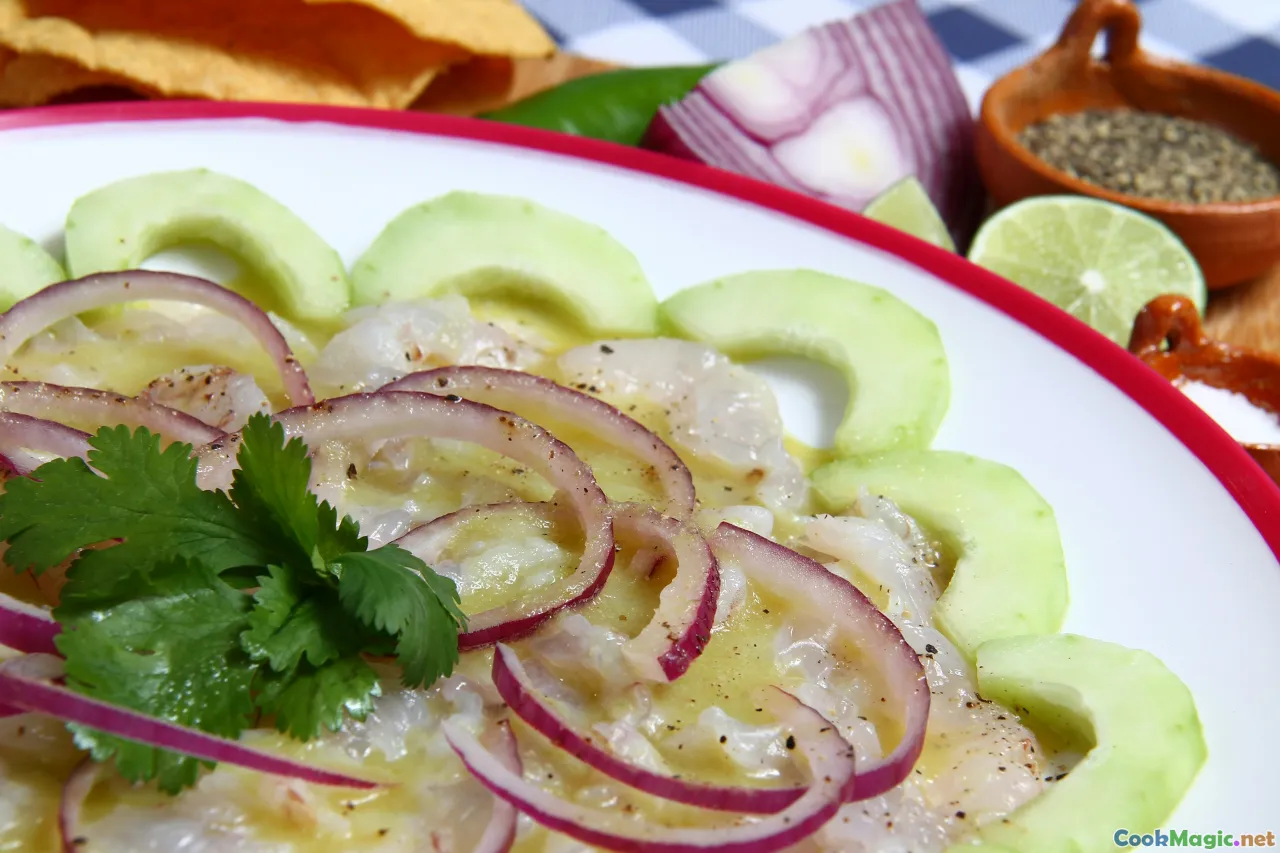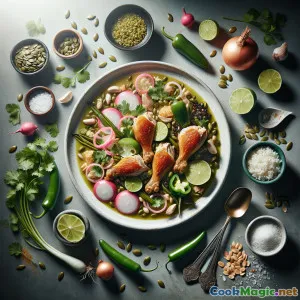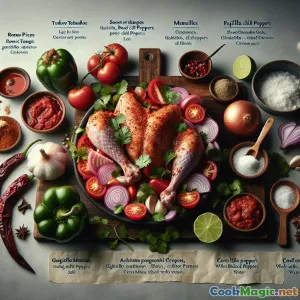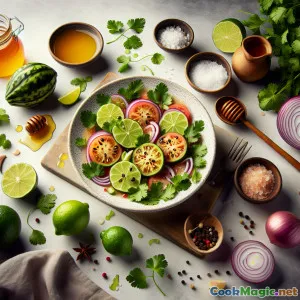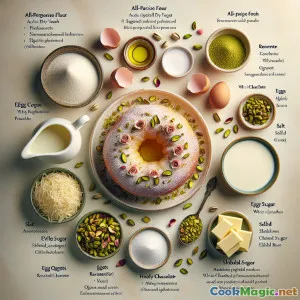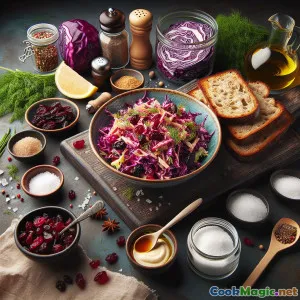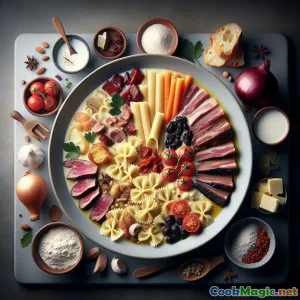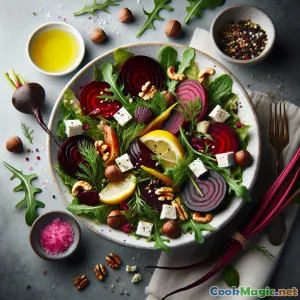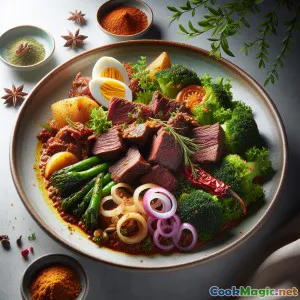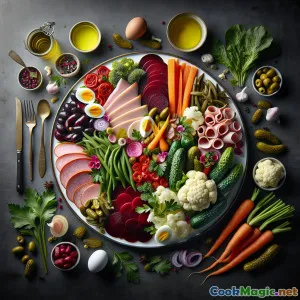
Цветной гватемальский ветчина к Дню всех Святых
(Colorful Guatemalan Fiambre for All Saints Day)
(0 Обзоры)0
393
июль 14, 2025
Сообщить о проблеме
Ингредиенты
-
200 grams Нарезанный отварной свекла
(Red or golden beets, boiled and chilled)
-
150 grams Отварная морковь
(Нарезанный)
-
120 grams Зеленая фасоль
(Trimmed and blanched)
-
120 grams Крупные соцветия цветной капусты
(Parboiled just until crisp)
-
250 grams Куриная грудка
(Poached, cooled and shredded)
-
200 grams Ветчина
(Sliced into thin strips)
-
100 grams Салями
(тонко нарезанный)
-
80 grams чоризо
(Нарезанный кругами)
-
100 grams Маринованный сыр (queso fresco)
(Нарежьте кубиками)
-
50 grams Маринованный молодой кукурузный початок
-
60 grams Маринованный лук
-
80 grams Маринованные огурцы
(Нарезанный)
-
80 grams Зеленые оливки
(Без косточек)
-
80 grams Черные оливки
(Без косточек)
-
4 large Яйца
(Hard boiled and quartered)
-
1 bunch Петрушка
(Свежие измельчённые травы для украшения)
-
1 head Листья салата
(Промыто и целое)
-
200 ml Винегрет
(Blend of olive oil, vinegar, a touch of Guatemalan mustard, black pepper, and oregano)
-
2 tbsp Каперсы
(Слив и промывание)
-
3 medium Редис
(Sliced thinly for decoration)
(Red or golden beets, boiled and chilled)
(Нарезанный)
(Trimmed and blanched)
(Parboiled just until crisp)
(Poached, cooled and shredded)
(Sliced into thin strips)
(тонко нарезанный)
(Нарезанный кругами)
(Нарежьте кубиками)
(Нарезанный)
(Без косточек)
(Без косточек)
(Hard boiled and quartered)
(Свежие измельчённые травы для украшения)
(Промыто и целое)
(Blend of olive oil, vinegar, a touch of Guatemalan mustard, black pepper, and oregano)
(Слив и промывание)
(Sliced thinly for decoration)
Питательная ценность
- Порции: 10
- Размер порции: 1 generous plate (350g)
- Calories: 360 kcal
- Carbohydrates: 19 g
- Protein: 22 g
- Fat: 19 g
- Fiber: 5 g
- Sugar: 6 g
- Sodium: 885 mg
- Cholesterol: 206 mg
- Calcium: 160 mg
- Iron: 2.7 mg
Инструкции
-
1 - Prepare Vegetables and Meats:
Peel and boil beetroots, carrots, green beans, and cauliflower. Cool thoroughly. Cook and chop chicken breast, ham, and chorizo if needed. Prepare all meats and cheeses by slicing thinly or cubing for assembly.
-
2 - Arrange Component Groups:
On a large platter or several plates, layer lettuce leaves as a base. Organize ingredients in neat, overlapping bunches—for instance, beets, pickle medley, assembled meats, then cheeses—to form vibrant stripes.
-
3 - Add Eggs and Decorative Veggies:
Quarter hard-boiled eggs and arrange over the salad. Add radish slices, pickled onions, corn, and top with olives and capers for color variety and flavor.
-
4 - Douse with Vinaigrette:
Mix together your olive oil, vinegar, mustard, pepper, and oregano. Lightly drizzle all over the salad, ensuring every group of vegetables, cheeses, and meats is treated. Let flavors marry in the fridge, covered, for at least 1 hour.
-
5 - Garnish and Serve:
Just before serving, sprinkle chopped fresh parsley. Serve directly from the platter, making sure each plate includes a representative cross-section of flavors and textures.
Peel and boil beetroots, carrots, green beans, and cauliflower. Cool thoroughly. Cook and chop chicken breast, ham, and chorizo if needed. Prepare all meats and cheeses by slicing thinly or cubing for assembly.
On a large platter or several plates, layer lettuce leaves as a base. Organize ingredients in neat, overlapping bunches—for instance, beets, pickle medley, assembled meats, then cheeses—to form vibrant stripes.
Quarter hard-boiled eggs and arrange over the salad. Add radish slices, pickled onions, corn, and top with olives and capers for color variety and flavor.
Mix together your olive oil, vinegar, mustard, pepper, and oregano. Lightly drizzle all over the salad, ensuring every group of vegetables, cheeses, and meats is treated. Let flavors marry in the fridge, covered, for at least 1 hour.
Just before serving, sprinkle chopped fresh parsley. Serve directly from the platter, making sure each plate includes a representative cross-section of flavors and textures.
Подробнее о: Цветной гватемальский ветчина к Дню всех Святых
The Story and Spirit Behind Guatemalan Fiambre Tradicional del 1 de Noviembre
If you've ever visited Guatemala during October’s end, you may encounter the dizzying scent of pickles, the tapestry-like color flashes of beets, peppers, green beans and eggs, all arranged magisterially onto platters that seem ablaze with edible confetti. This is Fiambre Tradicional del 1 de Noviembre—perhaps Guatemala’s most iconic cold salad and an appetizer, main dish, and centerpiece of memory-making all in one. It is joy, remembrance, unity, and family—flavors threaded across generations and afterlives.
Historical and Cultural Significance
Fiambre isn’t merely food. It’s a living quilt. This recipe has its roots deeply planted in colonial times with precedent in Spanish and Moorish antipasto. Over centuries, swept up through generations of Catholic influence and indigenous rituals honoring the dead, it emerged as Guatemala's commemorative Table of the Dead feast for Día de Todos los Santos (All Saints' Day, November 1st). Each family tweaks its own Fiambre recipe—an edible act of homage. Ingredients are selected not just for taste, but for their symbolic ties to deceased relatives: some meats for toughness (strength), eggs for life, and so on. Preparing Fiambre is a matter for consultation amongst ancestors—no two salads are ever truly the same from house to house or year to year.
Fiambre’s Unique Aspects
What sets Fiambre apart from anything you’ve tasted? It’s the sheer variety and balance. Cold, reserved vegetables (beets, cauliflower, carrots, beans, corn), prepared ahead and chilled, are an aromatic rainbow among finely sliced chorizo, salami, chicken, ham, and cheese. These are united with marinated vegetables like baby corn, capers, and myriad olives listed by the handful. Its vinaigrette, suffused with vinegar, smooth olive oil, Guatemalan mustard, oregano, sometimes even a trace of that family’s secret spice, soaks into the entire dish, marrying tang with the cooling mouthfeel and textural surprises.
After marinating, chilled for at least an hour, the dish is presented whole—a wild geometric layering of ingredients. Guests are served so each plate receives meat, veg, cheese, and garnish, welcoming all assembled and remembered. Some regions add seafood (fiambre rojo), while vegetarian takes exist (fiambre verde). Feel free to substitute local charcuterie or vegetarian sausages.
Preparing Fiambre at Home
Making fiambre is a task best done ahead—and even better as a collective event with family. Slice, cube, and allocate your components so that on an expansive platter, there’s visual order and balance: the slide of shining red beetroots laid against slices of pink ham, crisp florets of white cauliflower beside chartreuse gherkins, bright yellow pickled corn standing upright. Hard boiled eggs intersperse for softness, cheeses alternate for boldness. Set it all off with green herbs and savory vinaigrette.
It’s customary and practical to marinate the completed platter for an hour or more, giving flavors time to develop. Some even assemble it on October 31st, providing plenty of time for every meat and pickle to express its personality.
Serving and Personal Reflection
As a chef, few things are more gratifying than serving fiambre. The gasps from first-timers who marvel at the color story, followed by their beaming faces after the first bite—a taste surprising silky, bold, tart, sweet, deeply savory—illustrate its magic. Fiambre morphs the very idea of salad from a side act to main event; every version is a fingerprint for a family.
Beyond flavor, preparing fiambre brings people together: each person engaged at the table offers more than another set of hands—they put forward decades of memory and affection for those absent and present. It deepens one's respect for ancestors and celebrates identity—culinary, familial, and national. If you want to host a tradition that's intensely personal yet simultaneously inclusive, carve out a night this autumn for Fiambre.
Tips & Notes
- Advance preparation and refrigeration are key. Flavors improve overnight.
- Use a blend of fresh and pickled vegetables for authentic texture play.
- Don’t over-saturate with vinaigrette—drizzle lightly and allow guests to add their own.
- Arrange leftovers in jars—fiambre keeps well for days and develops increasingly complex flavors.
Honor, flavor, vivid memories, and the colors of life: that’s what awaits you in every bite of Fiambre Tradicional del 1 de Noviembre.

